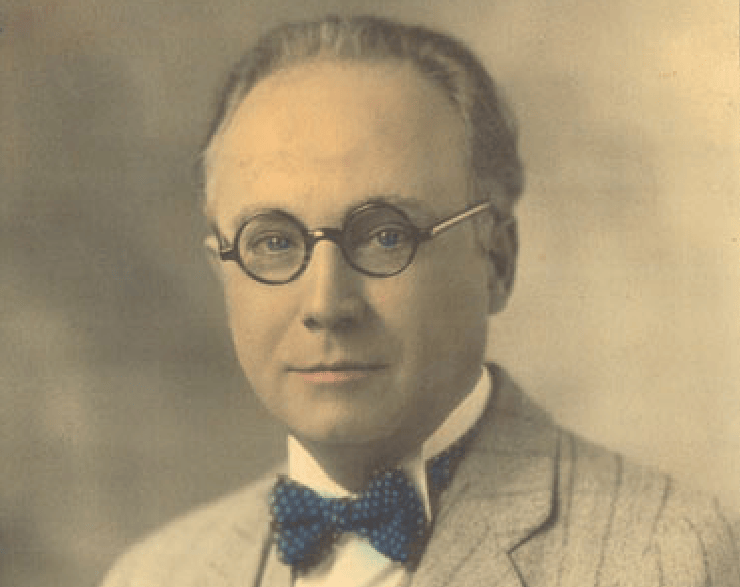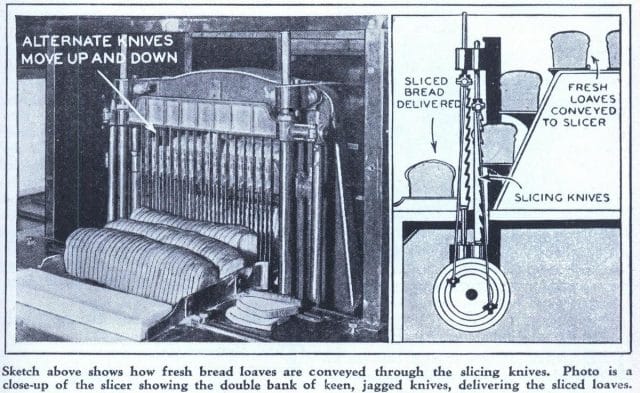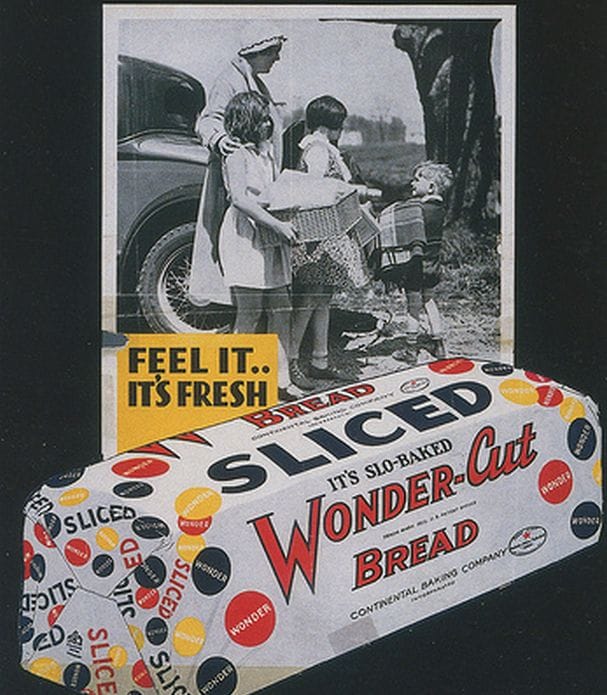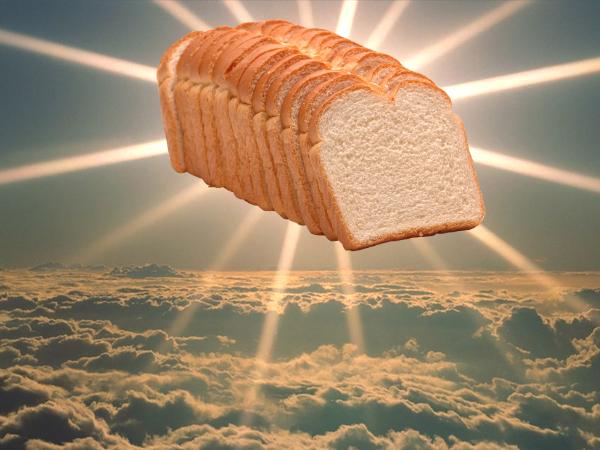
“The sliced loaf becomes a kind of small, edible promise of a better world.”
— Aaron Bobrow-Strain
For nearly 3,000 years, we’ve eaten bread. And we haven’t merely eaten it — it’s been the crown jewel of our diet: by the early 20th century, bread made up nearly one-third of the average American’s daily caloric intake.
Throughout most of history, we either baked the bread ourselves, or bought it from bakers in giant, solid loaves — until one man revolutionized the way we consumed it.
On the surface, sliced bread seems pretty simple. But it didn’t come easily: it’s an invention that endured tremendous hardships, tragedy, and years of innovation before hitting the shelves in the 1920s. It even toughed out a government ban during World War II.
And it began with a tenacious inventor named Otto.
Otto Rohwedder: The Unconquerable Slicer
Born in 1880 to German immigrants, Otto Rohwedder exhibited a rare breed of entrepreneurship early on. After spending his childhood in Davenport, Iowa tinkering with small chunks of wood and rudimentary tools, he moved to Chicago at age 20 and earned a degree in optometry. A year later, he changed professions entirely and began an apprenticeship with a local jeweler.
In 1905, he settled in St. Joseph, Missouri. Here, he excelled. Over the ensuing seven years, he acquired three jewelry shops and began inventing new tools and machines with his modest profits.
At the time, all loaves of bread were sold whole, so as to preserve freshness. But Rohwedder began to overhear a familiar complaint among housewives: slicing bread was burdensome, time-consuming, and sometimes even perilous (hardened, stale loaves required very sharp knifes).
What if, ruminated Rohwedder, there were a machine for bakers to pre-slice bread?
Otto Rohwedder, c. 1920s (colorized)
Trusting the great potential in his hypothetical invention, he immediately set out to conduct some market research. He put together a brief questionnaire “for the purpose of determining a thickness of slice which would be most nearly universal in acceptance,” and placed it as an ad in several large newspapers. Over the course of a few months, he managed to cull responses from 30,000 housewives.
Armed with this knowledge, he embarked on a long, painful journey to bring his invention to life.
He sold his jewelry businesses in 1916 and, with the profits, began building his first prototype in an abandoned warehouse outside of town. It was common knowledge that sliced bread didn’t maintain its soft texture as long as a whole loaf did, so the first problem Rohwedder had to address was coming up with a way to prolong freshness. His solution — inserting long hat pins in each end of the sliced loaf to hold it together — seemed to work initially, but bakers who tested the loaves complained that the metal pieces routinely fell out. For a year, Rohwedder retired to his warehouse and, with the feverish intensity of a mad scientist, sketched hundreds of blueprints.
Then, while manufacturing his machine in 1917, he endured every inventor’s worst nightmare: a fire broke out. His prototype and all of his blueprints — years of hard work and dedicated efforts — were burned to ash.
But Rohwedder refused to back down.
He found work as an investment and securities agent to support his family, slowly rebuilt his funds, and sought out investors to back his idea. By 1927, he’d built another bread slicing machine — one much better than his first a decade earlier. This time, instead of using pins, the machine tightly wrapped the sliced loaves in wax paper, both securing the individual pieces and keeping them fresh.
A year later, he filed a patent for a “single step bread slicing machine,” and formed his own company, Mac-Roh Sales & Manufacturing, to scale the production of his invention.
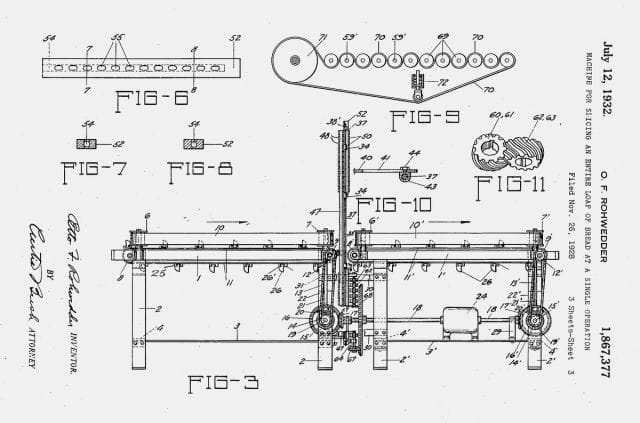

Rohwedder’s original patent illustrations
A 1928 issue of Modern Mechanics described the device’s ingenuity:
“Two banks of thin sharp steel blades are utilized…The cutting edges are all in the same plane and alternated so that while one blade moves upward its immediate neighbor moves downward…As the blades pass through the soft bread, the loaf closes immediately behind the blades and keeps the air out. These perfect surfaces fit snugly against each other and adhere surprisingly, thus retaining the freshness of the loaf.”
Despite early praise, when it came time to sell the machine to bakeries, Rohwedder was scoffed at.
For several months, nobody showed any interest in the device, which, at five feet wide by three feet high, was perceived to be too bulky and too complex for everyday bread production. On a last-resort whim, Rohwedder asked his friend Frank Bench, a baker on the brink of bankruptcy, if he’d give the slicer a shot. Though it was a substantial investment, Bench reluctantly agreed.
“When no one else in the world would give my father’s machine a try,” Rohwedder’s son told the Chillicothe Constitution-Tribune years later, “Frank Bench did.”
A sketch of Rohwedder’s bread slicing machine
The massive machine was installed in Chillicothe, Missouri at the Chillicothe Baking Company, and, on July 7, 1928, the first loaf of commercially sliced bread was sold. The sliced loaves, produced with the name Kleen Maid, were immensely popular, and elicited glowing reviews from the press:
“So neat and precise are the slices, and so definitely better than anyone could possibly slice by hand with a bread knife that one realizes instantly that here is a refinement that will receive a hearty and permanent welcome.
After all the idea of sliced bread is not unlike the idea of ground coffee, sliced bacon and many other modern and generally accepted products which combine superior results with a saving of time and effort.”
A full-page ad in Constitution-Tribune proudly stated that sliced bread was “the greatest forward step in the baking industry since bread was wrapped” — a phrase which was eventually hacked into the modern-day saying, “the greatest thing since sliced bread” (used since the 1950s to applaud exceptional inventions).
Frank Bench, the bankrupt baker who’s taken a chance on Rohwedder’s machine, was handsomely rewarded: within two weeks, his bread sales had increased by 2,000 percent.
“We are confident in the belief that the real possibilities of Sliced Bread have scarcely been scratched,” wrote Rohwedderin a 1930 issue of New South Baker, a bakery journal:
“I have seen enough bakers benefit in a big way from sliced bread to know that the same results can be obtained by any baker anywhere if he goes about the matter correctly. A good loaf, a proper presentation of Sliced Bread to the grocers and a truthful, clean advertising program based upon successful experiences and the baker can build his business far beyond what he could do without sliced bread.”
A few months later, one company heeded his advice.
The Continental Baking Company’s Wonder Bread
In late 1930, the New York-based Continental Baking Company using Rohwedder’s machines to build an entire business around sliced bread. Backed by exceptional marketing, their product — Wonder Bread — brought the popularity of sliced bread to new peaks: by 1933, nearly every reputable bakery in the country had at least one of Rohwedder’s bread slicing machines installed in its production room, and 80% of the bread produced in America was sliced.
Smitten with his success, Rohwedder sold his patent rights to industrial machinery company, Micro-Westco; he later joined on as an employee, eventually retiring in 1951 as a vice-president of sales.
The Government “Bans” Sliced Bread
Throughout the 1930s, housewives revelled in the joys of not having to slice dozens of pieces of bread every day. Then, without warning, sliced bread was no more.
In early 1943, citing wartime conservation efforts, U.S. Food Administrator Claude R. Wickard ordered a “ban” on sliced bread. “The ready-sliced loaf must have a heavier wrapping than an unsliced one if it is not to dry out,” he told the New York Times. “So, the order prohibiting the slicing of bread is aimed at effecting economies in the manufacture of bread and in the use of paper.”
Two weeks later, on January 18, the ban took effect, much to the dissatisfaction of homemakers. The outcry resulting from the ban was tremendous: in a New York Times letter to the editor, one woman furiously stated her opinion on the matter:
“I should like to let you see how important sliced bread is to the morale and saneness of a household.
My husband and four children are all in a rush before, during and after breakfast. Without ready-sliced bread I must do the slicing for toast — two pieces for each one — that’s ten.
For their lunches I must cut by hand at least twenty slices, for two sandwiches apiece. Afterward I make my own toast. Twenty-two slices of bread to be cut in a hurry.
They look less appetizing than the baker’s neat, even pieces. Haven’t the bakers already their bread-slicing machines and for thousands of loaves?
I should have to pay $7.95 for one, and I cannot afford even a good sharp knife.
Sue Forrester
Fairfield, Conn.”
At first, government officials warned dissenters — especially bakers continuing to slice bread — to back down. “To protect the cooperating bakeries against the unfair competition of those who continue to slice their own bread,” New York’s FDA supervisor told the Times, “we are prepared to take stern measures if necessary.”

New York Times headline, January 26, 1943
But the threats ultimately turned out to be short-lived.
On March 8 — less than three months later — Food Administrator Wickard lifted the ban. “The savings are not as much as we had expected,” he said, “and the War Production Board tells us that sufficient wax paper to wrap sliced bread for four months is in the hands of paper processor and the baking industry.”
The Benchmark for Ingenuity
Today, in an era saturated with fantastical, flashy inventions, sliced bread is often forgotten — but its importance shouldn’t be dismissed. Though the device itself was hardly the most revolutionary thing in history, the persistence of its creator — through loss, hardship, and doubt — is still remembered.
Deeming something to be “the greatest thing since sliced bread” is a testament to its ingenuity, but also to the indefatigable spirit of invention. It’s a testament to the decades Otto Rohwedder spent toiling in his workshop, to his refusal to give up.
And it is a tip of the cap to a man who believed that he could change the world — one slice at a time.
If you enjoyed this post, you’ might like our book → Everything Is Bullshit.
Written by Zachary Crockett; you can follow him on Twitter here. To get occasional notifications when we write blog posts, please sign up for our email list.




